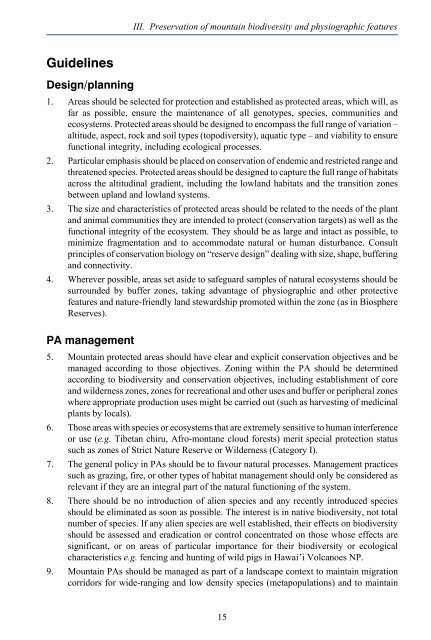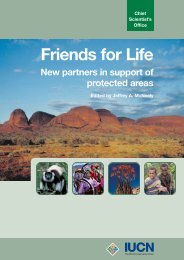Guidelines for Planning and Managing Mountain Protected Areas
Guidelines for Planning and Managing Mountain Protected Areas
Guidelines for Planning and Managing Mountain Protected Areas
- No tags were found...
You also want an ePaper? Increase the reach of your titles
YUMPU automatically turns print PDFs into web optimized ePapers that Google loves.
III. Preservation of mountain biodiversity <strong>and</strong> physiographic features<strong>Guidelines</strong>Design/planning1. <strong>Areas</strong> should be selected <strong>for</strong> protection <strong>and</strong> established as protected areas, which will, asfar as possible, ensure the maintenance of all genotypes, species, communities <strong>and</strong>ecosystems. <strong>Protected</strong> areas should be designed to encompass the full range of variation –altitude, aspect, rock <strong>and</strong> soil types (topodiversity), aquatic type – <strong>and</strong> viability to ensurefunctional integrity, including ecological processes.2. Particular emphasis should be placed on conservation of endemic <strong>and</strong> restricted range <strong>and</strong>threatened species. <strong>Protected</strong> areas should be designed to capture the full range of habitatsacross the altitudinal gradient, including the lowl<strong>and</strong> habitats <strong>and</strong> the transition zonesbetween upl<strong>and</strong> <strong>and</strong> lowl<strong>and</strong> systems.3. The size <strong>and</strong> characteristics of protected areas should be related to the needs of the plant<strong>and</strong> animal communities they are intended to protect (conservation targets) as well as thefunctional integrity of the ecosystem. They should be as large <strong>and</strong> intact as possible, tominimize fragmentation <strong>and</strong> to accommodate natural or human disturbance. Consultprinciples of conservation biology on “reserve design” dealing with size, shape, buffering<strong>and</strong> connectivity.4. Wherever possible, areas set aside to safeguard samples of natural ecosystems should besurrounded by buffer zones, taking advantage of physiographic <strong>and</strong> other protectivefeatures <strong>and</strong> nature-friendly l<strong>and</strong> stewardship promoted within the zone (as in BiosphereReserves).PA management5. <strong>Mountain</strong> protected areas should have clear <strong>and</strong> explicit conservation objectives <strong>and</strong> bemanaged according to those objectives. Zoning within the PA should be determinedaccording to biodiversity <strong>and</strong> conservation objectives, including establishment of core<strong>and</strong> wilderness zones, zones <strong>for</strong> recreational <strong>and</strong> other uses <strong>and</strong> buffer or peripheral zoneswhere appropriate production uses might be carried out (such as harvesting of medicinalplants by locals).6. Those areas with species or ecosystems that are extremely sensitive to human interferenceor use (e.g. Tibetan chiru, Afro-montane cloud <strong>for</strong>ests) merit special protection statussuch as zones of Strict Nature Reserve or Wilderness (Category I).7. The general policy in PAs should be to favour natural processes. Management practicessuch as grazing, fire, or other types of habitat management should only be considered asrelevant if they are an integral part of the natural functioning of the system.8. There should be no introduction of alien species <strong>and</strong> any recently introduced speciesshould be eliminated as soon as possible. The interest is in native biodiversity, not totalnumber of species. If any alien species are well established, their effects on biodiversityshould be assessed <strong>and</strong> eradication or control concentrated on those whose effects aresignificant, or on areas of particular importance <strong>for</strong> their biodiversity or ecologicalcharacteristics e.g. fencing <strong>and</strong> hunting of wild pigs in Hawai’i Volcanoes NP.9. <strong>Mountain</strong> PAs should be managed as part of a l<strong>and</strong>scape context to maintain migrationcorridors <strong>for</strong> wide-ranging <strong>and</strong> low density species (metapopulations) <strong>and</strong> to maintain15






